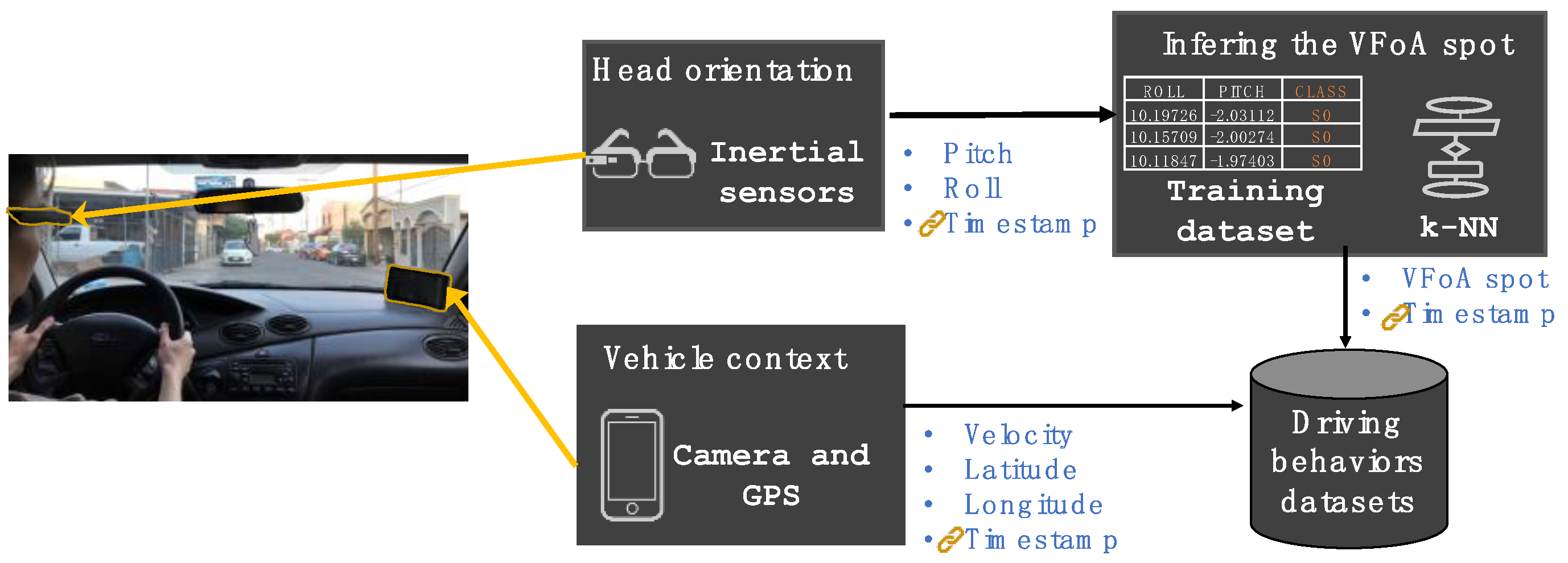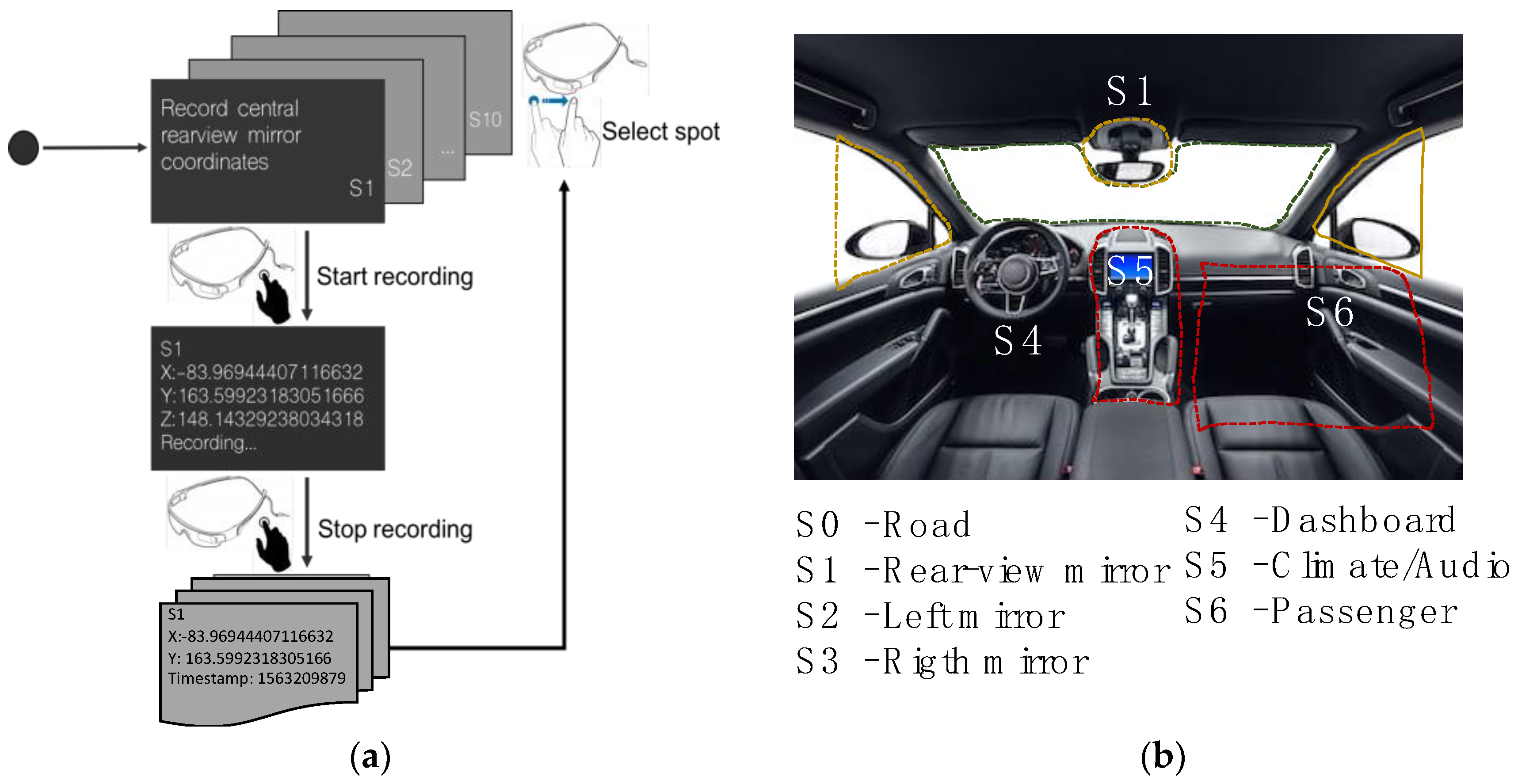A Sensing Architecture Based on Head-Worn Inertial Sensors to Study Drivers’ Visual Patterns †
Abstract
:1. Introduction
2. Related Work
2.1. Studies on Driving Behavior
2.2. Sensing Techniques to Infer Driving Behaviors
3. Scope of This Work
- secondary task distraction, which refers to the diverting of the driver’s attention away from the driving task, for instance, handling CDs and reaching for an object on the seat;
- driving-related inattention, it is directly related to the driving task such as checking the speedometer and mirrors;
- drowsiness, which includes eye closures and repeated yawing;
- non-specific eye-glance away from the forward roadway, it involves glances at no discernible object, person, or unknown location.
- RQ1: How variables associated with the driving context, such as speed and hierarchy of road, influence focusing visual attention on specific spots of the vehicle’s cockpit?
- RQ2: What are the technical design characteristics for developing a sensing architecture useful to characterize the drivers’ VFoA on spots of the vehicle’s cockpit?
4. Sensing Architecture
4.1. Vehicle Context Sensing Component
4.2. Head-Orientation Sensing Component
- Static sensing. In this mode, the component provides an application for the Google Glass to collect the head RA data and to label them with the corresponding cabin spot class drawing the drivers’ VFoA. The spot classes used for the aim of our study are presented in Figure 2b. The component should be used with the vehicle parked for safety reasons. As depicted in Figure 2a, the application requires to select the cabin spot to record through a sliding gesture, and a tap gesture to control (start/stop) the data recording. Thus, four-tuple vectors are registered to contain the RA of the head in x and y, the timestamp, and the label associated with the cabin spot drawing drivers’ VFoA. Thus, this component’s functioning mode is used to collect the training dataset that the k-NN algorithm uses to classify the data collected during driving sessions.
- Dynamic sensing. It is used to collect the head’s x and y RA during driving sessions and the corresponding Unix timestamp in milliseconds for every reading. The dataset gathered under this modality should be inputted into the k-NN algorithm to be classified as cabin spots classes.
4.3. Inferring the VFoA Spot
5. Sensing Study Design
- Glance frequency: We counted the times that drivers look at (eyes off-on-off) each spot.
- Glance duration: We estimated the time that each drivers’ glance lasts to a spot.
6. Results
6.1. Participants Data
6.2. Frequency of Glances and Hierarchy of Road
6.3. Glances Frequency and Driving Speed
6.4. Glances Duration and Driving Speed
7. Conclusions and Future Work
Funding
Acknowledgments
Conflicts of Interest
References
- Choi, H.; Kasko, J.; Feng, J. An Attention Assessment for Informing Older Drivers’ Crash Risks in Various Hazardous Situations. Gerontologist 2019, 59, 112–123. [Google Scholar] [CrossRef] [PubMed]
- Wechsler, K.; Drescher, U.; Janouch, C.; Haeger, M.; Voelcker-Rehage, C.; Bock, O. Multitasking During Simulated Car Driving: A Comparison of Young and Older Persons. Front. Psychol. 2018, 9, 910. [Google Scholar] [CrossRef] [PubMed]
- Murphy-Chutorian, E.; Trivedi, M.M. Head Pose Estimation and Augmented Reality Tracking: An Integrated System and Evaluation for Monitoring Driver Awareness. IEEE Trans. Intell. Transp. Syst. 2010, 11, 300–311. [Google Scholar] [CrossRef]
- Kazumi, R.; Masaaki, O.; Tomikazu, I.; Hiro, O.; Shigeyuki, T.; Marwhiro, M. Elderly Drivers’Hazard Perception and Driving Performance. In Proceedings of the International Conference of Traffic and Transport Psychology (ICTTP 2004), Nottingham, UK, 5–9 September 2004. [Google Scholar]
- Wikman, A.S.; Summala, H. Aging and time-sharing in highway driving. Optom. Vis. Sci. 2005, 82, 716–723. [Google Scholar] [CrossRef] [PubMed]
- Kim, B.-S.; Yi, Y.-C.; Kim, H.-W.; Lim, D.-H.; Bak, M.-S.; Ji, D.-H.; Min, Y.-K. The Characteristics of Elderly Drivers’ Driving Behavior on Intersection Using Graphic Driving Simulator. J. Ergon. Soc. Korea 2010, 29, 611–617. [Google Scholar] [CrossRef]
- Fancello, G.; Pinna, C.; Fadda, P. Visual perception of the roundabout in old age. WIT Trans. Built Environ. 2013, 130, 721–732. [Google Scholar] [CrossRef]
- Lau, M.Y.; Kaber, D. Driving performance, adaptation, and cognitive workload costs of logo panel detection as mediated by driver age. Adv. Intell. Syst. Comput. 2018, 597, 775–786. [Google Scholar] [CrossRef]
- Chen, Y.-L.; Ma, M.-Y.; Tseng, P.-Y.; Liu, Y.-C.; Ou, Y.-K. Study on the Analysis of Traffic Accidents Using Driving Simulation Scenario. In Advances in Intelligent Systems and Computing, Proceedings of the 20th Congress of the International Ergonomics Association (IEA 2018), Florence, Italy, 26–30 August 2018; Springer: Cham, The Netherlands, 2019; Volume 823, pp. 209–216. [Google Scholar] [CrossRef]
- Sun, Q.C.; Xia, J.C.; He, J.; Foster, J.; Falkmer, T.; Lee, H. Towards unpacking older drivers’ visual-motor coordination: A gaze-based integrated driving assessment. Accid. Anal. Prev. 2018, 113, 85–96. [Google Scholar] [CrossRef]
- Klauer, S.G.; Guo, F.; Simons-Morton, B.G.; Ouimet, M.C.; Lee, S.E.; Dingus, T.A. Distracted Driving and Risk of Road Crashes among Novice and Experienced Drivers. N. Engl. J. Med. 2014, 370, 54–59. [Google Scholar] [CrossRef]
- Dong, Y.; Hu, Z.; Uchimura, K.; Murayama, N. Driver Inattention Monitoring System for Intelligent Vehicles: A Review. IEEE Trans. Intell. Transp. Syst. 2011, 12, 596–614. [Google Scholar] [CrossRef]
- Fernández, A.; Usamentiaga, R.; Carús, J.L.; Casado, R. Driver Distraction Using Visual-Based Sensors and Algorithms. Sensors 2016, 16. [Google Scholar] [CrossRef] [PubMed]
- Ploetz, T.; Healey, J. ISWC 2017: Riding the Waves of Wearables. IEEE Pervas Comput. 2018, 17, 78–83. [Google Scholar] [CrossRef]
- Chou, W.-Y.; Yang, C.-H.; Tasi, H.-C.; Lin, Y.-C.; Chuang, C.-F.; Chen, K.-H. Driver distraction recognition based on dual compass motion sensoring. In Proceedings of the 17th International IEEE Conference on Intelligent Transportation Systems (ITSC 2014), Qingdao, China, 8–11 October 2014; pp. 1375–1380. [CrossRef]
- Chuang, C.-F.; Yang, C.-H.; Lin, Y.-H. HMM-based driving behavior recognition for in-car control service. In Proceedings of the 2015 IEEE International Conference on Consumer Electronics, Taipei, Taiwan, 6–8 June 2015; pp. 258–259. [Google Scholar] [CrossRef]
- Segawa, M.; Okada, M.; Renge, K.; Tada, M.; Noma, H.; Utsumi, A. Elderly driver retraining using automatic evaluation system of safe driving skill. IET Intell. Transp. Syst. 2014, 8, 266–272. [Google Scholar] [CrossRef]
- Sajan, S.; Ray, G. Human Factors in Safe Driving—A Review of Literature on Systems Perspective, Distractions and Errors. In Proceedings of the 2012 IEEE Global Humanitarian Technology Conference, Seattle, WA, USA, 21–24 October 2012; pp. 83–88. [Google Scholar] [CrossRef]
- Caird, J.K.; Johnston, K.A.; Willness, C.R.; Asbridge, M. The use of meta-analysis or research synthesis to combine driving simulation or naturalistic study results on driver distraction. J. Saf. Res. 2014, 49, 91.e1–96.e1. [Google Scholar] [CrossRef] [PubMed]
- Altman, N.S. An Introduction to Kernel and Nearest-Neighbor Nonparametric Regression. Am. Stat. 1992, 46, 175. [Google Scholar] [CrossRef]
- Chapter 3: Functional Classification—Flexibility—Publications—Environment—FHWA. (n.d.). Available online: https://www.fhwa.dot.gov/environment/publications/flexibility/ch03.cfm (accessed on 16 July 2019).


| Demographic Data | k-NN Performance on Static Mode | Driving Data Collected on Dynamic Mode | ||||
|---|---|---|---|---|---|---|
| Participant | Gender | Age | Error Rate (%) | Accuracy (%) | Speed 1 M (SD) | Speed 1 (M) on Local/Arterial Roads |
| P1 | Male | 21 | 0.11 | 99.89 | 17.45 (18.17) | 14.19/21.51 |
| P2 | Male | 21 | 0.20 | 99.80 | 20.30 (18.33) | 15.88/25.33 |
| P3 | Male | 20 | 0.25 | 99.75 | 17.11 (16.70) | 12.50/33.59 |
| P4 | Male | 22 | 0.29 | 99.71 | 17.74 (18.61) | 12.88/32.70 |
| P5 | Male | 21 | 0.46 | 99.54 | 22.03 (20.18) | 15.57/32.60 |
| P6 | Male | 25 | 0.12 | 99.88 | 19.36 (19.90) | 15.26/29.57 |
| P7 | Male | 29 | 0.36 | 99.64 | 20.62 (19.28) | 16.01/33.14 |
| P8 | Male | 22 | 0.04 | 99.96 | 19.90 (18.67) | 17.42/22.34 |
| P9 | Male | 22 | 0.20 | 99.80 | 26.18 (23.21) | 21.59/31.08 |
| P10 | Female | 21 | 0.30 | 99.70 | 16.78 (17.47) | 12.38/30.28 |
| P11 | Male | 23 | 0.20 | 99.80 | 24.25 (21.34) | 18.15/34.30 |
| P12 | Female | 21 | 0.00 | 100 | 20.79 (18.73) | 15.57/37.03 |
| P13 | Female | 22 | 0.14 | 99.86 | 30.42 (22.32) | 24.87/36.70 |
| P14 | Male | 25 | 0.02 | 99.98 | 16.38 (17.86) | 12.72/21.89 |
| P15 | Male | 21 | 0.15 | 99.85 | 21.18 (18.06) | 16.84/31.74 |
| Road (S0) | Rearview Mirror (S1) | Left-Mirror (S2) | Right-Mirror (S3) | Dash-Board (S4) | Audio/ Climate (S5) | Passenger (S6) | ||
|---|---|---|---|---|---|---|---|---|
| Local (residential zone) | Sum | 901 | 748 | 222 | 347 | 111 | 44 | 618 |
| Mean | 60.07 | 49.87 | 14.80 | 23.13 | 7.40 | 2.93 | 41.20 | |
| Std. Dev | 41.24 | 34.63 | 14.00 | 23.65 | 10.02 | 6.47 | 31.04 | |
| Arterial (Boulevard) | Sum | 310 | 269 | 68 | 131 | 27 | 4 | 255 |
| Mean | 22.14 | 19.21 | 4.86 | 9.36 | 1.93 | 0.29 | 18.21 | |
| Std. Dev | 32.08 | 31.39 | 8.47 | 10.92 | 3.26 | 1.25 | 19.63 | |
| Total | Sum | 1322 | 1141 | 311 | 485 | 142 | 52 | 922 |
| Mean | 88.13 | 76.07 | 20.73 | 32.33 | 9.47 | 3.47 | 61.47 | |
| Std. Dev | 70.05 | 65.17 | 20.45 | 32.62 | 13.16 | 6.81 | 49.75 |
Publisher’s Note: MDPI stays neutral with regard to jurisdictional claims in published maps and institutional affiliations. |
© 2019 by the authors. Licensee MDPI, Basel, Switzerland. This article is an open access article distributed under the terms and conditions of the Creative Commons Attribution (CC BY) license (https://creativecommons.org/licenses/by/4.0/).
Share and Cite
Armenta, J.S.; Rodríguez, M.D.; Andrade, A.G. A Sensing Architecture Based on Head-Worn Inertial Sensors to Study Drivers’ Visual Patterns. Proceedings 2019, 31, 34. https://doi.org/10.3390/proceedings2019031034
Armenta JS, Rodríguez MD, Andrade AG. A Sensing Architecture Based on Head-Worn Inertial Sensors to Study Drivers’ Visual Patterns. Proceedings. 2019; 31(1):34. https://doi.org/10.3390/proceedings2019031034
Chicago/Turabian StyleArmenta, Josué S., Marcela D. Rodríguez, and Angel G. Andrade. 2019. "A Sensing Architecture Based on Head-Worn Inertial Sensors to Study Drivers’ Visual Patterns" Proceedings 31, no. 1: 34. https://doi.org/10.3390/proceedings2019031034
APA StyleArmenta, J. S., Rodríguez, M. D., & Andrade, A. G. (2019). A Sensing Architecture Based on Head-Worn Inertial Sensors to Study Drivers’ Visual Patterns. Proceedings, 31(1), 34. https://doi.org/10.3390/proceedings2019031034






